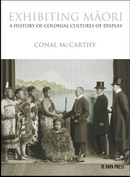review by Philippa Mein Smith

In this richly illustrated monograph, Conal McCarthy traces changes in the way museums and exhibitions have displayed things Maori since the Victorian era, exploring shifts in meaning from curio and specimen to arts and crafts, followed by art ('primitive' and modern) and taonga (cultural treasure). The book begins with the display life of a waharoa (gateway) carved for the international exhibition in Christchurch's Hagley Park in the summer of 1906–7 that encapsulated the then fashionable idea of New Zealand as Maoriland. By the end of the century the same gateway had transmuted into a precious heritage item and permanent exhibit at Te Papa, the new national museum, symbolic both of bicultural New Zealand and of the museum's mission to serve as an entrance to the nation's heritage.
A review of the literature exposes the book's origins in a PhD thesis. Though a theoretical review is useful for a museum audience attuned to questions about agency and cultural reception, for a general audience it would have sufficed to explain the book's purpose of reconstructing exhibitions within their social context. For this New Zealand case of analysing how people, in particular Maori, interacted with exhibitions of their culture through time is valuable for the insights it provides not only into museum attitudes and practice but into race dynamics in a settler society. Exhibiting Maori, as its title suggests, surveys the exhibition of Indigenous Maori objects throughout New Zealand's short history. A core theme is of Maori collaboration, which led to the reclaiming of the culture of display as a consequence of a Maori revival in the twentieth century. In the process the National Museum (thus named from 1972) became Indigenised in aiming to be 'our place' for all New Zealanders. Conal McCarthy conveys his message clearly not to take theory too seriously and instead to observe social relations. In the New Zealand case — which he acknowledges may be exceptional — the objects talked back; more Maori now visit museums because museums tell their story.
There are two main strengths of Exhibiting Maori. First is the portrayal of indigenous exhibits through time. As a bonus, the book's superb series of images are available electronically from the Museum of New Zealand Te Papa Tongarewa. Although many Maori taonga are found in museums overseas, such as the Musée du quai Branly in Paris, the treasures here comprise a selection of the museum's photographs, art work and material culture in dynamic relationship with people as audience, artists and performers. To have such a rich array of images published in one volume itself is a valuable contribution to the field. Second is the associated account of how Maori resisted and engaged with the process of exhibiting Maori and reclaimed control. Even in the nineteenth century Maori participated in New Zealand displays at exhibitions in Philadelphia and Sydney.
Images and live performances, McCarthy suggests, were not necessarily imperialising but evidence of Maori agency and enterprise. As in other spheres of ethnic relations, the New Zealand experience is shown to complicate the standard interpretation of the subjugation of native peoples because participants saw themselves as partners in colonial development. Among numerous examples, chiefs such as Tureiti Te Heuheu Tukino and Tamahau Mahupuku had a bicultural vision of working with the Colonial (later Dominion) Museum in Wellington to record Maori history, which led them to collaborate with the museum's director Augustus Hamilton and ethnologist Elsdon Best. At the Christchurch exhibition in 1906, the bicultural MP James Carroll spoke of the Maori pa exhibit as a chiefly representation and thus a symbol of strength and survival rather than of a dying race. By 1986, the Te Maori exhibition returned home in triumph from New York to transform New Zealand museums' culture of display through collective and individual Maori engagement.
Given the author's convincing argument that Maori have interacted and been involved with exhibitions since at least 1865 when the Colonial Museum was established, it is distracting at times that he accords so much voice to the theory criticised. In fact it is the author's voice that is worth hearing rather than the extensive quotations. McCarthy offers a fresh view based on archival research and interviews that reveals Maori to have been not objects or merely an audience for their exhibits but museum patrons since the nineteenth century. Through his study of Te Papa's resources he demonstrates how the display of material things embodies a 'living relation to living peoples' (p. 199). This pattern of social relations has ebbed and flowed with other trends in New Zealand history. Its recovery has the potential to shed new light on Maori–Pakeha relations in New Zealand, while it challenges and exposes the limits of postcolonial critique.
Philippa Mein Smith is an associate professor of history in the School of History, University of Canterbury, New Zealand.
